Command List
This command list has every command under vhs-decode/cvbs-decode/hifi-decode/ld-decode and secondary items such as key scripts and the ld-tools suite.
These must be set for any decoder to work period.
- Frequency (Sample rate of Input RF data files)
- Tape Format (VHS or Video8 etc)
- TV System (Defines tape speed & colour system)
- Input & Output (Input files & Output names either local folder or full path)
Example Command
-f, frequency Manual setting of Input Frequency in integers of hz, mhz, ghz or 4fsc/5fsc/8fsc/10fsc (or CXADC Designators) the default is 40msps 16-bit the rate the DomesDayDuplicator uses (decoder is 8-bit/16-bit agnostic & 10-bit packed is unpacked automatically)
--tf, --tape_format Sets tape format to decode VHS, SVHS, UMATIC, UMATIC_HI, Hi8, Video8, BETAMAX, BETAMAX_HIFI, EIAJ, TYPEC, VCR (default is VHS) Tape Formats List
Note
BETAMAX_HIFI is for tapes with a HiFi FM track, for Linear audio tapes use just BETAMAX.
--no_resample Experimental Skips internal resampling to 40mhz, allows for native use of lower sample rates i.e 16-28msps and faster decoding.
-t, --threads Threads Sets Number of CPU processing threads default is 1, there is no limit but decoding will only utilise 6-8 threads at upto 10fps observed on x86 and upto 16fps on Apple M2 Silicon (Note: Decoding is primarily single-core & cache speed biased)
--use_saved_levels Experimental Skips doing most of the level detect code on each frame and only does it at the start or if there are issues detecting syncs. Provides a speedup in decoding and seems to work okay on captures that only have one single recording of media.
--level_detect_divisor (Default 2) Experimental (May lower processing time)
Currently, 1-6 value, 1 every sample, 2 every other sample and so on, Changes vsync serration code only use every nth sample when determining sync/blank levels higher value lower accuracy.
--params_file <filename> Changes the decoder settings to use an external .json file with the correct formatting.
Example:
Create a new text file, use this template and then save it as a custom-params.json file.
Note these values vary by tape format & TV System please read Advanced Parameter Adjustment for examples.
{
"sys_params":{
"burst_abs_ref":5000
},
"rf_params":{
"video_lpf_freq":3000000
}
}
--debug Outputs full debug logging with timestamps, helpful for damaged tapes or keeping track of frames and decode time, costs a small but relatively negligible amount of extra processing time.
--skip_hsync_refine Skip refining line locations using hsync, less accurate line start detection but may avoid issues in some cases..
--dp & --debug_plot Do a plot for the requested data, separated by whitespace. Current options are: "
+ plot_options
+ ".",
--dp deemphasis Shows the deemphasis curve (note it's not very detailed atm and think it might just show 0-Nyquist rather than properly labelled)
--dp demodblock Displays Raw Demodulated Frequency Spectrum Graphs, makes a pop-up window per each thread so -t 32 would give you 32 GUI windows etc
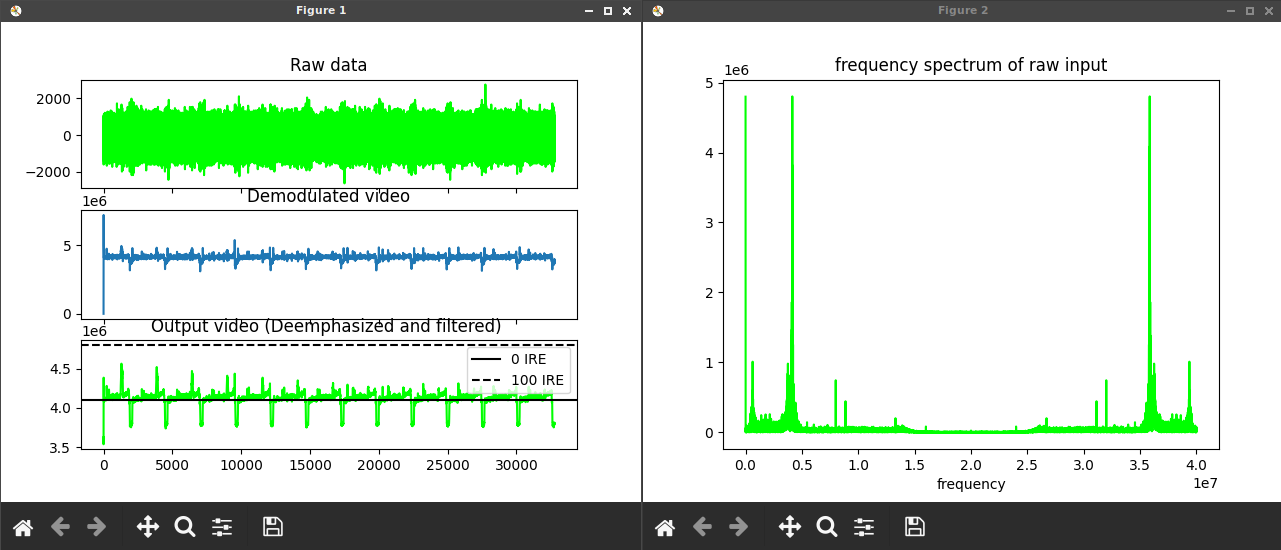
-s, --start Jumps ahead to any given frame in the capture.
--start_fileloc Jumps ahead to any given sample in the capture.
-l, --length Limits decode length to n frames.
--overwrite Overwrite existing decode files if present.
--sl, --sharpness Sharpness Level 0-100 Value sets the level of visual sharpness, default 0, Higher values are better suited for plain, flat images i.e. cartoons and animated material, as strong ghosting can occur and or excessive noise (akin to cranking up the sharpness on any regular TV set.)
-L,--level_adjust Multiply top/bottom IRE in JSON by 1 +/- this value controls Black/White video levels, adjustment can be used to avoid clipping on RGB conversion in chroma decode.
--recheck_phase Re-check chroma phase on every field, useful for multiple recordings on one single VHS tape for example. (No effect on U-matic)
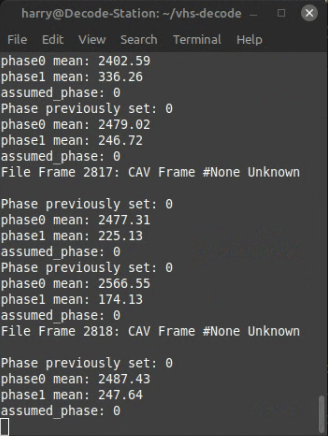
--drh, --disable_right_hsync Horizontal Sync Check, Corrects warping in the horizontal lines and corrects the line start position of the video frame, this option Disables the use of the right side of hsync for lineloc detection (old behaviour)
--noAGC (deprecated, already disabled by default) Disables Automatic Gain Control image brightness/gamma levels use if fluctuating
--AGC Enables Automatic Gain Control
--ct, --chroma_trap Enables Chroma Trap Intended to reduce chroma interference on the main luma signal, Recommended to use if seeing banding or checkerboarding on the main luma .tbc in ld-analyse.
--y_comb Enables Y Channel comb filter (Luminance), optionally specifying IRE limit like --y_comb 5 this option is used to eliminate crosshatch/diamond patterns sometimes found in decoded images.
--nocomb Disables Croma Combing, Disable's internal chroma comb filter.
--sclip --sync_clip Enables Sync Clipping
--nodd Disable diff demod
--nld, --non_linear_deemphasis Can help reduce ringing and oversharpening. (WIP). (Used for hi-band formats and VHS LP/SP)
--sd, --sub_deemphasis Enables non-linear sub deemphasis. (WIP).
--skip_chroma Don't output chroma even for formats that may have it and possibly skip some of the chroma processing.
--export_raw_tbc Export a raw TBC without deemphasis applied, intended for filter tuning.
-D, --dod_t, --dod_threshold_p RF Dropout level fraction Threshold for dropouts in percentage of average (in decimal)
--noDOD Disables Drop Out Detection Default is on. (But processed after the fact with ld-dropout-correct/gen_chroma_vid scripts)
--dod_h, --dod_hysteresis The RF level needs to go above the dropout threshold multiplied by this for a dropout to end.
--dod_t_abs, --dod_threshold_abs RF Dropout level threshold absolute value.
Note
RF levels vary greatly between tapes & recording setups.
--clamp Enable blanking DC offset clamping/compensation, disabled by default can improve if white level is extremely high.
--fm_audio_notch Applies an extra layer of filtering on the video signal for tapes with HiFi FM tracks that may cause interference on the picture signal.
--noclamp Disables blanking DC offset clamping/compensation.
--fallback_vsync Enable vsync detect fallback. (Will be enabled by default after further testing)
--cafc Chroma Automatic Frequency Control (AFC) Enables, down-converted chroma carrier AFC, implies --recheck_phase
-T If set to 0 or 1, force use of video track phase.
--high_boost Multiplier for boost to high RF frequencies uses default if not specified, can improve if black streaks are appearing in decodes, at cost of sharpness. (May change)
NTSC VHS Tape with high frequency dropouts
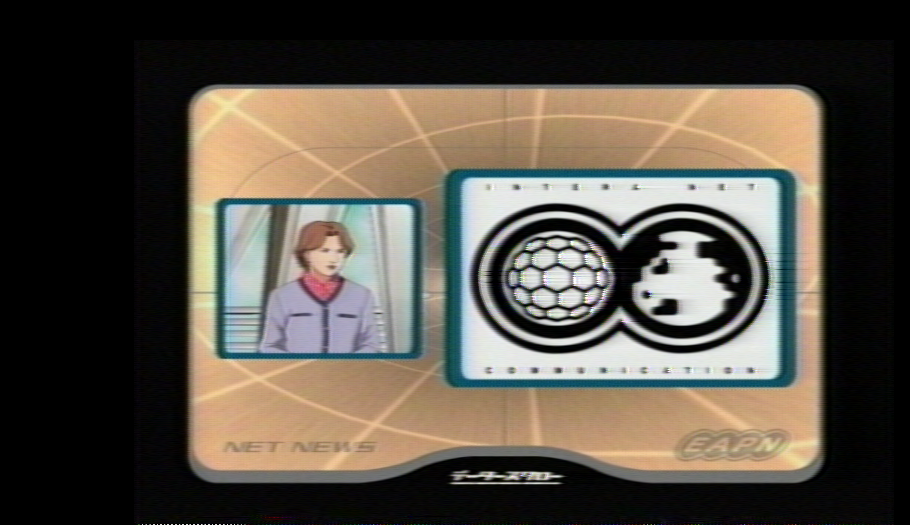
Tape corrected with --high_boost 5
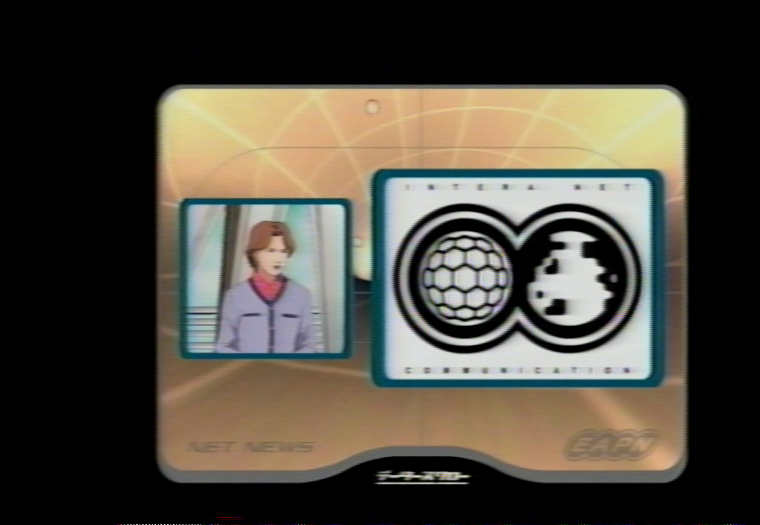
--notch define the centre frequency for the optional built-in notch "bandpass" filter.
--notch_q define Q factor Intended primarily for reducing noise from interference however, the decoder logic already compensates based on tape type and TV System values.
--system = pal, pal-m, ntsc, ntsc-j, --mesecam
-n = NTSC Fully Supported.
-p = PAL Fully Supported.
-pm = PAL-M Experimental.
--NTSCJ = NTSC-J Fully Supported.
--MESECAM = MESECAM Support Added.
--cxadc 28.6 MHz/8-bit (8fsc) Stock Crystal Native 8xFsc 8bit Unsigned
--cxadc3 35.8 MHz/8-bit (10fsc) Stock Crystal Native 4xFsc 16bit Unsigned
--10cxadc 14.3 MHz/16-bit (4fsc) Stock Crystal 1.25x 8xFsc 8bit Unsigned
--10cxadc3 17.9 MHz/16-bit (5fsc) Stock Crystal 1.25x 4xFsc 16bit Unsigned
Full real-world usage is in its own independent tbc-video-export doc
It has its own docs and wiki, as its primary intended to automate the majority of long-hand manual command arguments metadata and audio muxing its real-world use is on its own export guide doc.
Installed via pipx on Linux/MacOS:
pipx install tbc-video-export
You can also download self contained binary's for all platform's and is the defacto for Windows use and bundled with the decode suite releases.
This tool is an more advanced evolution of the gen_chroma_vid.sh, using python and bringing with it cross-platform and a full suite of automation features.
- Automaticaly can run ld-process-vbi, ld-dropout-correct, ld-efm-decoder
- Supports both CVBS & S-Video TBC Sets
- Supports auto audio muxing & ld-decode output
- Supports VITC timecode
- Clear readout dialog of encode process
- Correctly flagged interlaced and progressive video files
- FFmpeg Based Encoding Profiles
This script allows for chroma TBC data to be decoded by ld-chroma-decoder and combined to make standard colour video files.
Simple Use Example: gen_chroma_vid.sh input-tbc-name
Outputs an FFV1 10-bit 4:2:2 .mkv video file to the same directory as the TBC file.
Note! inputs and outputs can be drag and drop added in Ubuntu/Mint GUI environments.
-i or --input
Name of the input, without extension. This option is mandatory.
--input-json
Manually specify the input JSON file. (This is automatic based off input TBC name)
-v or --videosystem
Manually sets video system PAL/NTSC etc (This is now automatic based off .json file)
-a or --audio
Optional Audio track (*.wav, mp3, aac et. al.) to mux with generated video.
-s or --start
Specify the start frame number.
-l or --length
Specify the length (number of frames to process)
--chroma-gain (Saturation) Gain factor applied to chroma components (default 1.5 for PAL, 2.0 for NTSC)
--chroma-phase (Hue) Phase rotation applied to chroma components (degrees; default 0.0)
-b or --blackandwhite Output video in black and white.
Pixel formats (colour encoding) are currently:
-p or --output-format
(FFmpeg output formats; default yuv422p10le "4:2:2 10bit")
RGB - RGB48 (RGB 16-16-16)
8-Bit 4:2:2 - yuv420p
8-Bit 4:4:4 - yuv444p
10-Bit 4:2:2 - yuv422p10le
10-Bit 4:4:4 - yuv444p16
16-bit Grey Scale - gray16
--pad or --output-padding Pad the output frame to any multiple of 2 (needs testing)
The Following commands adjust the image output in the vertical plane, horizontal adjustment is yet to be implemented.
--ffll, --first_active_field_line <number> The first visible line of a field.
Range's
1-259 for NTSC (default: 20)
2-308 for PAL (default: 22)
--lfll, --last_active_field_line <number> The last visible line of a field.
Range's
1-259 for NTSC (default:259)
2-308 for PAL (default: 308)
--ffrl, --first_active_frame_line <number> The first visible line of a frame.
Range's
1-525 for NTSC (default: 40)
1-620 for PAL (default: 44)
--lfrl, --last_active_frame_line <number> The last visible line of a frame.
Range's
1-525 for NTSC (default:525)
1-620 for PAL (default: 620)
-f or --full
Sets output to full-frame of composite video signal 1135x625 PAL & 910x525 NTSC Experimental
These set your output to give you a full vertical image with the VBI area 928x624 PAL 760x528 NTSC
PAL:
--ffll 2 --lfll 308 --ffrl 2 --lfrl 620 <tbc-name>
NTSC:
--ffll 1 --lfll 259 --ffrl 2 --lfrl 525 <tbc-name>
This produces an image like this on SVHS allowing you to see or manually read data in the VBI area such as the VITC Timecode shown:

These commands work well for 16:9 widescreen letterbox crop tapes rendering only the centre making a 928x432 PAL & 760x432 NTSC Image ideal for scaling/de-interlacing to 1280x720p 50/60p for Blu-Ray mastering.
PAL:
--ffll 2 --lfll 308 --ffrl 118 --lfrl 548 <tbc-name>
NTSC:
--ffll 2 --lfll 308 --ffrl 118 --lfrl 453 <tbc-name>
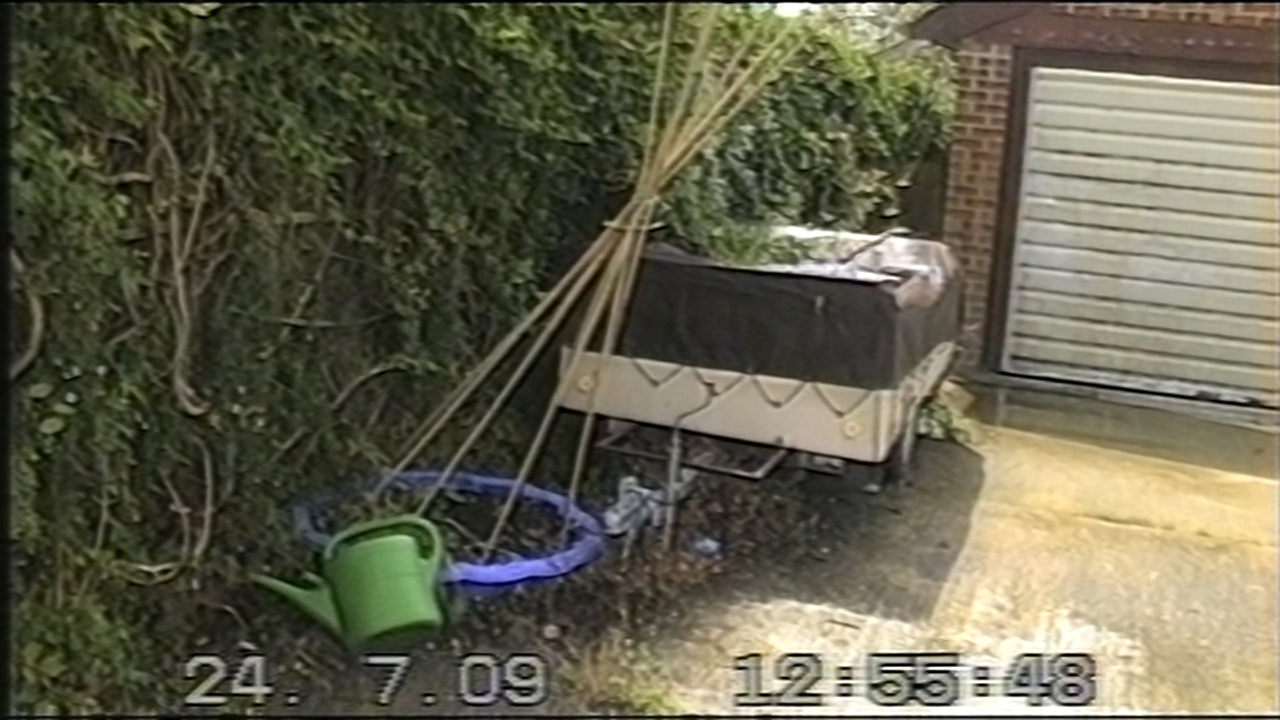
--decoder Manually sets chroma decoder to use (default is automatic)
PAL: pal2d, transform2d, transform3d
NTSC ntsc1d, ntsc2d, ntsc3d, ntsc3dnoadapt
-r or --reverse Reverse the field order to second/first (default first/second)
-t or --threads Specify the number of concurrent CPU processing threads (default number of logical CPUs)
-q or --quiet Suppress info and warning messages
-o or --oftest NTSC: Overlay the adaptive filter map (only used for testing)
--chroma-nr <number> NTSC: Chroma noise reduction level in dB (default 0.0)
--luma-nr <number> Luma noise reduction level in dB (default 1.0)
--simple-pal Transform: Use 1D UV filter (default 2D)
--transform-mode <mode> Filter mode to use (level, threshold; default threshold)"
--transform-threshold <number> Uniform similarity threshold in 'threshold' mode (default 0.4)"
--transform-thresholds <file> File containing per-bin similarity thresholds in 'threshold' mode"
--show-ffts Overlay the input and output FFTs (Fast Fourier Transforms)
--ntsc-phase-comp Use NTSC QADM decoder taking burst phase into account (BETA)
(Semi-Deprecated due to ld-process-vbi support)
Thanks to FFmpeg we have a useful filter to read this data in software, although it is technically human readable.
Simply edit the below commands and replace "input.tbc" / "input.mkv" and "output.mkv" / "vitc.txt" with your input files and desired output name.
ld-process-vbi
You will see the HH:MM:SS:FF counter at the bottom of ld-analyse when viewing the TBC files.

ffmpeg -i input.mkv -vf "readvitc=scan_max=-1,metadata=print:file=vitc.txt" -f null -
This will make a human-readable .txt file if the filter correctly detects the data.
.TBC to Luma (Black & White) only.
PAL
ld-chroma-decoder --ffll 2 --lfll 308 --ffrl 2 --lfrl 620 <tbc-name>
NTSC
ld-chroma-decoder --ffll 2 --lfll 308 --ffrl 2 --lfrl 520 <tbc-name>
PAL
ffmpeg -hide_banner -y -async 1 -f rawvideo -pix_fmt gray16 -video_size 1135x626 -i "input.tbc" -vf "readvitc=scan_max=-1,metadata=print:file=vitc.txt" -f null -
NTSC
ffmpeg -hide_banner -y -async 1 -f rawvideo -pix_fmt gray16 -video_size 910x526 -i "input.tbc" -vf "readvitc=scan_max=-1,metadata=print:file=vitc.txt" -f null -
PAL
ffmpeg -hide_banner -y -async 1 -f rawvideo -pix_fmt gray16 -video_size 1135x626 -i "input.tbc" -vf "il=l='i':c='i',bwdif" -c ffv1 -pix_fmt gray16le -aspect 939:626 -r 50 "output.mkv"
NTSC
ffmpeg -hide_banner -y -async 1 -f rawvideo -pix_fmt gray16 -video_size 910x526 -i "input.tbc" -vf "il=l='i':c='i',bwdif" -c ffv1 -pix_fmt gray16le -aspect 760:526 -r 60000/1001 "output.mkv"
Currently, this decoder will work just fine with stable signals and live media.
Example Usage Command:
./cvbs-decode --debug --pal -A --cxadc composite-test.u8 composite-test
To stop the decode press Ctrl+C
Extract VBI Data to .JSON:
ld-process-vbi composite-test.tbc
Export to Video
You can use tbc-video-export or ld-chroma-decoder manually.
Just like vhs-decode & ld-decode the default is 40msps 8-bit/10-bit/16-bit input.
Captures can be FLAC compressed (.cvbs) or Uncompressed .u8/u16 etc
-f Frequency Adjust in integers of hz, mhz, ghz or 4fsc/5fsc/8fsc/10fsc
--cxadc 28.6 MHz/8-bit (8fsc) Stock Crystal Native 8xFsc 8bit Unsigned Sampling Mode
--cxadc3 35.8 MHz/8-bit (10fsc) Stock Crystal Native 4xFsc 16bit
--10cxadc 14.3 MHz/16-bit (4fsc) Stock Crystal 1.25x 8xFsc 8bit Unsigned Sampling Mode
--10cxadc3 17.9 MHz/16-bit (5fsc) Stock Crystal 1.25x 4xFsc 16bit
-n NTSC
--NTSCJ NTSC-J
-p PAL
--pm PAL-M
--debug Enables debug detailed logging output.
-A Automatic Sync Detection (Currently Mandatory For CVBS-Decode to work)
-S Seek Frame of Capture
--right_hand_hsync Use right-hand horizontal sync detection.
--ct Chroma Trap, cleans up chroma interference on the luma channel.
--sl Defines sharpness by default this is set to 0. (0-100 Range)
--notch Define the centre frequency for the optional built-in notch "bandpass" filter.
--notch_q defines the Q factor Intended primarily for reducing noise from interference however, the decoder logic already compensates based on tape type and TV System values.
In-file RF Data can be FLAC compressed or raw 8-bit or 16-bit
i,g s16, u8, .flac, ldf
TV System, NTSC or PAL system speeds.
out-file Audio Data must have an .wav or .flac extension manually at the end.
Example:
Linux/MacOS
hifi-decode -p --cxadc HiFI-Audio-PAL-28.6msps-8-bit.u8 hifi-decode-output.flac
Windows
decode.exe hifi --pal --cxadc HiFI-Audio-PAL-DdD.s16 hifi-decode-output.flac
--ui Enables GUI mode using QT.
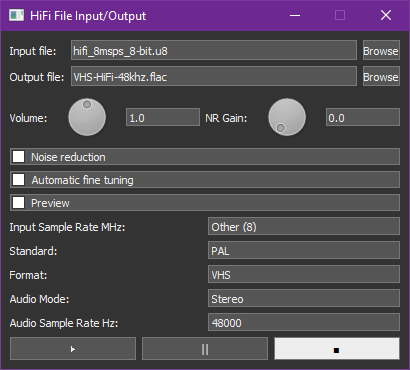
--system pal / ntsc
n, --ntsc - NTSC
p, --pal - PAL
-f, --frequency Manual Input Hz, MHz, GHz.
-f 40 - DomesDay Duplicator (DdD)
-f 8 - RTLSDR
-f 10 - CX Card Clock Gen Setup
--cxadc 28.6 MHz/8-bit (8fsc)
--cxadc3 35.8 MHz/8-bit (10fsc)
--10cxadc 14.3 MHz/16-bit (4fsc) (Technically 4fsc NTSC)
--10cxadc3 17.9 MHz/16-bit (5fsc) (Technically 4fsc PAL)
--bg Forces guessing of the carrier bias.
-t To set the threads for parallel decoding.
--original To force use of vhs-decodes FM demodulation.
--preview Enables a faster decoder for real-time preview. (faster and noisier)
--noise_reduction NOISE_REDUCTION Set noise reduction on/off (default is on)
--auto_fine_tune AUTO_FINE_TUNE Set auto tuning of the analogue front end on/off (useful for mixed standards tapes)
--NR_sidechain_gain Sets the noise reduction envelope tracking sidechain gain (default is 33). Range (20~100): 100 being a hard gate effect, operating range should be 40 and below (dynamic range decompressor adjustment smaller = more aggressive)
--h8 Sony 8mm Video8 & Hi8 tape formats HiFi FM (Not PCM)
--gnuradio Opens ZMQ REP pipe to gnu-radio at port 5555, the sample rate for gnu-radio is 8388608 Hz.
-h, --help show this help message and exit
--debug enable verbose logging
-t threads, --threads threads number of CPU threads to use
-f FREQ, --frequency FREQ RF sampling frequency in source file (default is 40MHz) FREQ can be a bare number in MHz, or a number with one of the case-insensitive suffixes Hz, kHz, MHz, GHz, fSC (meaning NTSC) or fSCPAL.
--analog_audio_frequency AFREQ RF sampling frequency in source file (default is 44100hz)
infile source file
outfile base name for destination files
--start file-location, -s file-location rough jump to frame n of capture (default is 0)
--length frames, -l frames limit length to x number of frames
--seek frame, -S frame seek to frame n of capture
--start_fileloc start_fileloc jump to precise sample # in the file
--PAL, -p, --pal Source is in PAL format
--NTSC, -n, --ntsc Source is in NTSC format
--NTSCJ, -j Source is in NTSC-J (IRE 0 black) format
--noEFM Disable EFM front end
--preEFM Write filtered but otherwise pre-processed EFM data
--disable_analog_audio, --disable_analogue_audio, --daa Disable analog(ue) audio decoding
--AC3 Enable AC3 audio decoding (NTSC only)
--audio_filterwidth FREQ Analog audio filter width
--noAGC Disable AGC
--noDOD Disable dropout detector
--ignoreleadout Continue decoding after lead-out seen
-m mtf, --MTF mtf Mtf compensation multiplier
--MTF_offset mtf_offset Mtf compensation offset
--lowband Use more restricted RF settings for noisier disks
--RF_TBC Create a .tbc.ldf file without decoding, only time base corrects the signal.
--verboseVITS Enable additional JSON fields
--NTSC_color_notch_filter, -N Mitigate interference from analogue audio in reds in NTSC captures
--V4300D_notch_filter, -V LD-V4300D PAL/digital audio captures: remove spurious ~8.5mhz signal
-d deemp_adjust, --deemp_adjust Deemphasis level multiplier
--deemp_low deemp_low Deemphasis low coefficient
--deemp_high deemp_high Deemphasis high coefficient
--video_bpf_high FREQ Video BPF high end frequency
--video_lpf FREQ Video low-pass filter frequency
--video_lpf_order VLPF_ORDER Video low-pass filter order
Say for some reason you have a source file in a certain format that you are either piping or otherwise can't change the extension of to get *-decode to recognize the datatype.
You can use mkfifo to create a named pipe to overcome this.
Example: mkfifo link.u8
flac -d u8capture.flac --force-raw-format --endian=little --sign=unsigned -o link.u8 -f |vhs-decode link.u8 out/u8capture
ld-chroma-decoder is used to render the TBC to a full-colour video file you can render to y4m or pipe to FFmpeg.
The chroma-decoder can use over 20GB of ram if available and can run in real-time on fairly modern systems.
The decoder has lots of options that can be tweaked but the list of pre-made commands below will get you started with a good basic export with proper interlaced flagging.
Use ld-chroma-decoder -h to list all the options available to the decoder.
Replace INPUT.tbc and OUTPUT.mkv with your desired names.
For standard output this list of export commands is provided you only need to change setdar=4/3 to setdar=16/9 for widescreen content.
- Active + VBI area
- FFV1 (4:2:2) (Lossless Compressed)
- V210 (4:2:2) (Uncompressed)
- ProRes HQ (4:2:2) (Visually Lossless)
- Y4M (4:4:4) (Uncompressed)
- V410 (4:4:4) (Uncompressed)
- ProRes 4444QX (4:4:4) (Visually Lossless)
(Y4M Only*) you can use these 2 commands.
NTSC
ld-chroma-decoder --ffll 1 --lfll 259 --ffrl 2 --lfrl 525 --decoder ntsc3d -p y4m -q INPUT.tbc OUTPUT.mov
PAL
ld-chroma-decoder --ffll 2 --lfll 308 --ffrl 2 --lfrl 620 --decoder transform3d -p y4m -q INPUT.tbc OUTPUT.mov

NTSC
ld-chroma-decoder --decoder ntsc3d -p y4m -q INPUT.tbc| ffmpeg -i - -c:v ffv1 -level 3 -coder 1 -context 1 -g 60 -slicecrc 1 -vf setfield=tff -flags +ilme+ildct -color_primaries smpte170m -color_trc bt709 -colorspace smpte170m -color_range tv -pix_fmt yuv422p10le -vf setdar=4/3,setfield=tff OUTPUT.mkv
PAL
ld-chroma-decoder --decoder transform3d -p y4m -q INPUT.tbc| ffmpeg -i - -c:v ffv1 -level 3 -coder 1 -context 1 -g 60 -slicecrc 1 -vf setfield=tff -flags +ilme+ildct -color_primaries bt470bg -color_trc bt709 -colorspace bt470bg -color_range tv -pix_fmt yuv422p10le -vf setdar=4/3,setfield=tff OUTPUT.mkv
NTSC
ld-chroma-decoder --decoder ntsc3d -p y4m -q INPUT.tbc| ffmpeg -i - -c:v v210 -f mov -top 1 -vf setfield=tff -flags +ilme+ildct -pix_fmt yuv422p10le -color_primaries smpte170m -color_trc bt709 -colorspace smpte170m -color_range tv -vf setdar=4/3,setfield=tff OUTPUT.mov
PAL
ld-chroma-decoder --decoder transform3d -p y4m -q INPUT.tbc| ffmpeg -i - -c:v v210 -f mov -top 1 -vf setfield=tff -flags +ilme+ildct -pix_fmt yuv422p10le -color_primaries bt470bg -color_trc bt709 -colorspace bt470bg -color_range tv -vf setdar=4/3,setfield=tff OUTPUT.mov
NTSC
ld-chroma-decoder --decoder ntsc3d -p y4m -q INPUT.tbc| ffmpeg -i - -c:v prores -profile:v 3 -vendor apl0 -bits_per_mb 8000 -quant_mat hq -f mov -top 1 -vf setfield=tff -flags +ilme+ildct -pix_fmt yuv422p10le -color_primaries smpte170m -color_trc bt709 -colorspace smpte170m -color_range tv -vf setdar=4/3,setfield=tff OUTPUT.mov
PAL
ld-chroma-decoder --decoder transform3d -p y4m -q INPUT.tbc| ffmpeg -i - -c:v prores -profile:v 3 -vendor apl0 -bits_per_mb 8000 -quant_mat hq -f mov -top 1 -vf setfield=tff -flags +ilme+ildct -pix_fmt yuv422p10le -color_primaries bt470bg -color_trc bt709 -colorspace bt470bg -color_range tv -vf setdar=4/3,setfield=tff OUTPUT.mov
NTSC
ld-chroma-decoder --decoder ntsc3d -p y4m -q INPUT.tbc OUTPUT.mov
PAL
ld-chroma-decoder --decoder transform3d -p y4m -q INPUT.tbc OUTPUT.mov
NTSC
ld-chroma-decoder --decoder ntsc3d -p y4m -q INPUT.tbc| ffmpeg -i - -c:v v410 -f mov -top 1 -vf setfield=tff -flags +ilme+ildct -pix_fmt yuv444p10le -color_primaries smpte170m -color_trc bt709 -colorspace smpte170m -color_range tv -vf setdar=4/3,setfield=tff OUTPUT.mov
PAL
ld-chroma-decoder --decoder transform3d -p y4m -q INPUT.tbc| ffmpeg -i - -c:v v410 -f mov -top 1 -vf setfield=tff -flags +ilme+ildct -pix_fmt yuv444p10le -color_primaries bt470bg -color_trc bt709 -colorspace bt470bg -color_range tv -vf setdar=4/3,setfield=tff OUTPUT.mov
NTSC
ld-chroma-decoder --decoder ntsc3d -p y4m -q INPUT.tbc| ffmpeg -i - -c:v prores -profile:v 5 -vendor apl0 -bits_per_mb 8000 -mbs_per_slice -f mov -top 1 -vf setfield=tff -flags +ilme+ildct -pix_fmt yuv444p10le -color_primaries smpte170m -color_trc bt709 -colorspace smpte170m -color_range tv -vf setdar=4/3,setfield=tff OUTPUT.mov
PAL
ld-chroma-decoder --decoder transform3d -p y4m -q INPUT.tbc| ffmpeg -i - -c:v prores -profile:v 5 -vendor apl0 -bits_per_mb 8000 -mbs_per_slice 8 -f mov -top 1 -vf setfield=tff -flags +ilme+ildct -pix_fmt yuv444p10le -color_primaries bt470bg -color_trc bt709 -colorspace bt470bg -color_range tv -vf setdar=4/3,setfield=tff OUTPUT.mov
- FAQ - Frequently Asked Questions
- Diagram Breakdowns
- Visual-Comparisons
- VCR Reports / RF Tap Examples
- Download & Contribute Data
- Speed Testing
- Visual VBI Data Guide
- Closed Captioning
- Teletext
- WSS Wide - Screen Signalling
- VITC Timecode
- VITS Signals
- XDS Data (PBS)
- Video ID IEC 61880
- Vapoursynth TBC Median Stacking Guide
- Ruxpin-Decode & TV Teddy Tapes
- Tony's GNU Radio For Dummies Guide
- Tony's GNU Radio Scripts
- DomesDay Duplicator Utilities
- ld-decode Utilities
